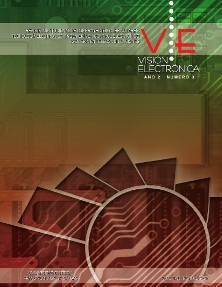DOI:
https://doi.org/10.14483/22484728.18420Publicado:
2019-03-13Número:
Vol. 2 Núm. 1 (2019): Edición especialSección:
Visión de CasoEnergy saving system with wireless sleep sensor
Sistema de ahorro energético con sensor inalámbrico de sueño
Palabras clave:
Z-Wav, Estado de sueño, Sensor, Domótica, Ahorro energético, Frecuencia respiratoria (es).Palabras clave:
Z-Wave, Sleep state, Sensor, Domotic, Energy saving, Respiratory rate (en).Descargas
Resumen (en)
In the following paper, perform the development and evaluation of a device capable of identifying the sleep state of a person from the measurement of the respiratory frequency, integrating it into a Z-Wave system to perform spatial domotic control. It was evidenced, by means of the analysis of electrical consumption tests, how the implementation of the system generates a significant saving of 38% with respect to the average monthly consumption in a house, and how its application contributes to an environment conducive to sleep by reducing noise that generate the multimedia equipment in the room -off immediately after a detection-. The correct functioning of the sensor is observed due to the characteristics of the measurements of quality of service (QoS) parameters: Delay, Throughput and Jitter, guaranteeing that the loss of information is null and that the system implemented is viable.
Resumen (es)
En el siguiente artículo se realiza el desarrollo y evaluación de un dispositivo capaz de identificar el estado de sueño de una persona a partir de la medición de la frecuencia respiratoria, integrándolo a un sistema tipo Z-Wave para realizar control domótico espacial. Se evidenció, por medio del análisis de pruebas de consumo eléctrico, cómo la implementación del sistema genera un ahorro significativo del 38% con respecto al consumo promedio mensual en una vivienda, y cómo su aplicación contribuye con un entorno propicio para dormir al disminuir el ruido que generan los equipos multimedia en la habitación -apagados inmediatamente después de una detección-. Se observa un correcto funcionamiento del sensor por las características de las mediciones de los parámetros de calidad de servicio (QoS): Delay, Throughput y Jitter, garantizándose que la pérdida de información es nula y que el sistema implementado es viable.
Referencias
Banco Mundial, "Población, total | Data," Https://Datos.Bancomundial.Org/, 2017. [Online]. Available: https://datos.bancomundial.org/indicador/SP.POP.TOTL
Banco Mundial, "Consumo de energía eléctrica (kWh per cápita) | Data," World Bank Group, 2018. [Online]. Available: https://datos.bancomundial.org/indicador/EG.USE.ELEC.KH.PC%0Ahttps://datos.bancomundial.org/indicador/EG.USE.ELEC.KH.PC?locations=EC
Z-Wave Alliance, "About Z-Wave Technology." [Online]. Available: https://z-wavealliance.org/about_z-wave_technology/
ITU, "ITU-T G99.59 Short range narrow-band digital radiocommunication transceivers - PHY and MAC layer specifications," 2012.
C. Wei, Y. Chen, C. Chang, and C. Yu, "The Implementation of Smart Electronic Locking System Based on Z-Wave and Internet," in 2015 IEEE International Conference on Systems, Man, and Cybernetics, 2015, pp. 2015-2017, doi:10.1109/SMC.2015.351. https://doi.org/10.1109/SMC.2015.351
C. Yuan, H. Wang, and J. He, "Remote Monitoring System Based on MC9S12NE64 and Z-WAVE Technology," in 2010 International Conference on E-Product E-Service and E-Entertainment, 2010, pp. 1-4. https://doi.org/10.1109/ICEEE.2010.5661481
Y. Hou, Y. Wang, and Y. Zheng, "TagBreathe: Monitor Breathing with Commodity RFID Systems," in 2017 IEEE 37th International Conference on Distributed Computing Systems (ICDCS), 2017, pp. 404-413. https://doi.org/10.1109/ICDCS.2017.76
M. B. Yassein, W. Mardini, and A. Khalil, "Smart homes automation using Z-wave protocol," in 2016 International Conference on Engineering & MIS (ICEMIS), 2016, pp. 1-6, https://doi.org/10.1109/ICEMIS.2016.7745306
K. Motoi et al., "A fully automated health-care monitoring at home without attachment of any biological sensors and its clinical evaluation," in 2009 Annual International Conference of the IEEE Engineering in Medicine and Biology Society, 2009, pp. 4323-4326, https://doi.org/10.1109/IEMBS.2009.5333712
Mingjiang Wang et al., "A matress system for human biosignals monitoring," in Proceedings of the IEEE 2012 Prognostics and System Health Management Conference (PHM-2012 Beijing), 2012, pp. 1-5, https://doi.org/10.1109/PHM.2012.6228967
G. Csernath, L. Szilagyi, G. Fordos, and S. M. Szilagyi, "A novel ECG telemetry and monitoring system based on Z-Wave communication," in 2008 30th Annual International Conference of the IEEE Engineering in Medicine and Biology Society, 2008, pp. 2361-2364, https://doi.org/10.1109/IEMBS.2008.4649673
D. C. Mack, M. Alwan, B. Turner, P. Suratt, and R. A. Felder, "A Passive and Portable System for Monitoring Heart Rate and Detecting Sleep Apnea and Arousals: Preliminary Validation," in 1st Transdisciplinary Conference on Distributed Diagnosis and Home Healthcare, 2006. D2H2., 2006, pp. 51-54, https://doi.org/10.1109/DDHH.2006.1624795
L. C. Chen, K.-W. Chen, and Y.-P. Hung, "A sleep monitoring system based on audio, video and depth information for detecting sleep events," in 2014 IEEE International Conference on Multimedia and Expo (ICME), 2014, pp. 1-6, https://doi.org/10.1109/ICME.2014.6890292
J. Kempfner, P. Jennum, M. Nikolic, J. Christensen, and H. Sorensen, "Automatic detection of REM sleep in subjects without atonia," 2012 Annual International Conference of the IEEE Engineering in Medicine and Biology Society, vol. 5, pp. 4242-4245, 2012, https://doi.org/10.1109/EMBC.2012.6346903
V. Gupta, S. Mittal, S. Bhaumik, and R. Roy, "Assisting humans to achieve optimal sleep by changing ambient temperature," in 2016 IEEE International Conference on Bioinformatics and Biomedicine (BIBM), 2016, pp. 841-845, https://doi.org/10.1109/BIBM.2016.7822635
N. Patwari, L. Brewer, Q. Tate, O. Kaltiokallio, and M. Bocca, "Breathfinding: A Wireless Network That Monitors and Locates Breathing in a Home," IEEE Journal of Selected Topics in Signal Processing, vol. 8, no. 1, pp. 30-42, Feb. 2014, https://doi.org/10.1109/JSTSP.2013.2287473
P. Barsocchi, M. Bianchini, A. Crivello, D. La Rosa, F. Palumbo, and F. Scarselli, "An unobtrusive sleep monitoring system for the human sleep behaviour understanding," in 7th IEEE International Conference on Cognitive Infocommunications, CogInfoCom 2016 - Proceedings, 2017, no. CogInfoCom, pp. 91-96, https://doi.org/10.1109/CogInfoCom.2016.7804531
R. Chen and Y. Lin, "Using ZeeBee Sensor Network with artifical neural network for indoor location," in 2012 8th International Conference on Natural Computation, 2012, no. Icnc, https://doi.org/10.1109/ICNC.2012.6234591
K. Tonchev, P. Koleva, A. Manolova, G. Tsenov, and V. Poulkov, "Non-intrusive sleep analyzer for real time detection of sleep anomalies," in 2016 39th International Conference on Telecommunications and Signal Processing (TSP), 2016, pp. 400-404, https://doi.org/10.1109/TSP.2016.7760906
M. Smolen, K. Czopek, and P. Augustyniak, "Non-invasive Sensors based Human State in Nightlong Sleep Analysis for Home-care," pp. 45-48, 2010.
H. University, "Healthy Sleep," 2007. [Online]. Available: http://healthysleep.med.harvard.edu/healthy/science/what/characteristics
I. Iskandar and A. Hidayat, "Analisa Quality of Service (QoS) Jaringan Internet Kampus (Studi Kasus: UIN Suska Riau)," Jurnal CoreIT, vol. 1, no. 2, pp. 2460-738, 2015.
University of Rochester Medical Center, "Vital Signs (Body Temperature, Pulse Rate, Respiration Rate, Blood Pressure) - Health Encyclopedia - University of Rochester Medical Center." 2017.
National Sleep Foundation, "2011 Sleep in America Poll," Washignton, 2011.
UIT, "UIT-T G.1010 Categorías de calidad de servicio para los usuarios de extremo de servicios multimedios," 2001.
C. Sexton, "Poor sleep quality is associated with increased cortical atrophy in community-dwelling adults," Neurology, 2014. https://doi.org/10.1212/WNL.0000000000000774
Cómo citar
APA
ACM
ACS
ABNT
Chicago
Harvard
IEEE
MLA
Turabian
Vancouver
Descargar cita
Licencia
Derechos de autor 2019 Visión electrónica

Esta obra está bajo una licencia internacional Creative Commons Atribución-NoComercial 4.0.
.png)
atribución- no comercial 4.0 International






.jpg)





